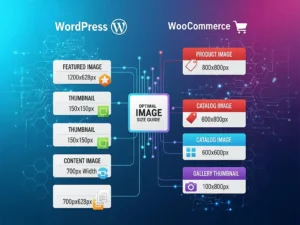1. Why optimise images for SEO?
Images are visual elements that enrich the user experience and complement the textual content of your site. However, in order for them to actively contribute to the success of your online strategy, it is crucial to master the art of SEO for images.
Optimising SEO for images is an essential practice for ensuring your site’s visibility and effectiveness on search engines. By introducing the concept of SEO for images, we’re talking about specific techniques aimed at improving your site’s positioning in search results, attracting organic traffic and providing a richer user experience.
Attractive, optimised images not only complement textual content, but also serve as a draw for visitors, making your site more attractive to search engines and users.
What is SEO for images?
SEO for images consists of optimising images so that they are easily indexed and understood by search engines such as Google. This means that images that are relevant to users’ searches will be more likely to appear in results via Google Images, but also in normal search results, increasing organic traffic to your site.
Importance of SEO for images:
- Increased Organic Traffic: SEO-optimised images can attract qualified visitors to your site who are actively looking for information or products related to your business.
- Improved SEO Positioning: Image optimisation contributes to your site’s overall ranking in search results, boosting your online visibility.
- Enriched User Experience: Optimised images improve the user experience, making your site more attractive and easier to navigate.
- Accessibility for All: Image optimisation with alt text ensures that people with visual impairments or in environments without image loading can understand the content of the images.
Benefits for Institutional Sites and E-commerce:
Institutional Websites: SEO for images can increase a brand’s visibility, strengthen its online reputation and attract new customers.
E-commerce: SEO for images is crucial to the success of an e-commerce site, as it directly influences the conversion rate, the user experience and the visibility of products in search results.
2. Name images correctly
Have you ever had a hard drive full of files with names like “IMG_0001.jpg” or “IMG_0002.png”? You probably have! But did you know that this way of naming images could be harming your site’s SEO?
Why is it important to give images descriptive names?
For search engines like Google, images are like huge closed boxes. They can slightly understand the content through the file size and format, but they can’t see what the image actually represents. This is where descriptive names with keywords come in!
Imagine you have a surf e-commerce business and you have a fantastic photo of a new surfboard. Instead of saving it as “IMG_7893.jpg”, give it a descriptive name like “surfboard-model-xpto-2024.jpg”.
- Improves the SEO ranking of images: Descriptive names with relevant keywords help Google understand the content of the image and associate it with related searches. This can improve your site’s ranking in these searches and consequently attract more organic traffic.
- Increases Traffic from Google Images: Did you know that Google Images is a powerful search engine? By optimising images with relevant names, you can appear in image search results, directing interested visitors to your site.
Tips for naming images correctly:
- Be descriptive: Avoid generic names and opt for names that describe the content of the image.
- Use keywords: Insert keywords that are relevant to the theme of the image, but avoid keyword stuffing or keyword overload.
- Be concise: Use hyphen separators (-) instead of underscores (_).
- Appropriate length: Keep names relatively short and easy to read.
Examples:
- Instead of “IMG_3456.jpg” use “dress-party-red-sleeve-long.jpg”
- Instead of “foto-praia.jpg” use “praia-praia-algarve-mar-azul.jpg”
By implementing these simple tips, you will be taking an important step towards optimising your images for good SEO for images and opening the door to more organic traffic and qualified visits to your site.
This practice not only improves indexation in search results but also contributes to a better user experience.
3. Technical optimisation: size and formats
As we’ve already mentioned, poorly optimised images can harm your site’s performance, negatively affecting loading times and, consequently, your ranking in search results.
The importance of image size and format
The size and format of an image are two crucial factors for technical optimisation in SEO for images. The size of the image refers to the weight of the file, while the format refers to its extension (e.g. JPEG, PNG, SVG, WEBP).
Balance between quality and weight

The aim of technical optimisation is to find a balance between the visual quality of the image and its weight. Images with a high resolution and large size can have excellent visual quality, but can slow down page loading times. On the other hand, images with a smaller size can load quickly but have poorer visual quality.
The ideal weight for a normal website or even an e-commerce site is 100Kb. If we consider a website dedicated to digital art or photography where image quality is very important, the weight of each image could reach 200Kb.
However, it is advisable that the images on a page never exceed 2Mb in total.
Choosing the right format
Each image format has its own characteristics.
- JPEG is ideal for photographs with vibrant colours and is the most popular and widely used format
- PNG is best suited to images with text or fine lines and supports transparency and is widely used for logos.
- SVG is recommended for icons and vector illustrations such as social media symbols.
- WebP is a new generation image format that is becoming increasingly popular on the web due to its advantages over traditional formats such as JPEG and PNG. It has a smaller file size and generally compresses images with a loss of quality similar to JPEG, but with a much smaller file size. As far as visual quality is concerned, despite the compression, WebP manages to maintain a visual quality close to the original image. Like PNG, WebP allows images with transparency, which is useful for graphic elements with an invisible background. WebP also supports light animations and can be an alternative to GIFs in some cases.
Image optimisation tools
There are a number of online and offline tools that help with image optimisation. Some popular options include:
- TinyPNG: https://tinypng.com/
- Compressor.io: https://compressor.io/
- ImageOptim: https://imageoptim.com/
Image dimensions
And are dimensions also important? Of course they are.
Whenever we browse for images, we usually only find horizontal or landscape images and most of them are almost always the same size.
The two dimensions most favoured by Google are 16:9 (e.g. 1024x 576) and 4:3 (850 x 637). The tendency is for images with the characteristics described to appear first, leaving vertical images or images with other proportions for last.
Other technical optimisations
The technical optimisation of images is crucial to ensuring the efficient performance of your site. Choosing the right size and format is a delicate balance between maintaining visual quality and reducing file weight to improve page load times. Correctly optimised images not only reduce loading time, which is crucial for user retention, but also contribute to the SEO ranking of images, since search engines value faster sites.
Use caching so that images load more quickly on subsequent visits to the site, as they are stored locally in the user’s browser.
Another optimisation technique you can use is “Lazy Loading”
Lazy Loading is a website performance optimisation technique that consists of delaying the loading of certain elements, such as images or videos, until they are needed. Instead of loading all the images as soon as the user accesses the page, Lazy Loading allows you to load only the images that are visible in the user’s field of vision or those that are about to be viewed as the user scrolls down the page.
This technique
- improves loading times by delaying the loading of elements that are not immediately visible,
- saves bandwidth by avoiding unnecessary loading of resources,
- improves the user experience by contributing to a more fluid user experience,
- reduces device resource consumption, especially on mobile devices and computers with limited resources that can benefit significantly from reduced resource consumption
- improves the SEO performance of images, since search engines value pages that load quickly.
- Reduces bounce rates since users can start interacting with the content more quickly
- Supports images below the fold (Above the Fold) by prioritising the loading of initially visible elements, ensuring that the most important part of the page, which is immediately visible (“above the fold”), is loaded quickly.
4. Keyword strength: titles and alt tags
“Keyword power” plays a crucial role in SEO for images, especially when incorporated into descriptive image titles and alt tags.
Why Descriptive Titles and Alt Tags?
Before we dive into the specific strategies, it’s essential to understand why descriptive image titles and alt tags are so vital in SEO for images.
Search engines can’t “see” images in the same way as humans, so they rely on these elements to understand visual content.
Including relevant keywords in these components not only helps search engines understand the context, but also improves the user experience as it provides additional descriptions.
Titles, descriptions, captions and alt tags
Four elements are important for SEO for images each in their own way:
- Descriptive titles: The image title is usually the name of the file and should appear when you hover your mouse over the image. It’s important that the title is descriptive and includes keywords relevant to the content of the image.
- Descriptions: The image description is text that provides more information about the image. It is important that the description is informative and includes keywords relevant to the content of the image.
- Captions: The image caption is text that appears below the image. It is important that the caption is concise and informative, and that it also includes keywords relevant to the content of the image.
- Alt tags: The alt tag is a textual description of the image. It is important that the alt tag is descriptive and informative, and that it includes keywords relevant to the content of the image. It also plays a very important role for blind users as this is the text that will describe the image.
Keywords
When choosing keywords for the titles, descriptions, captions and alt tags of your images, it’s important to bear the following in mind:
- Relevance: The keywords must be relevant to the content of the image.
- Specificity: The keywords should be as specific as possible.
- Popularity: The keywords should be popularly searched for by users.
Images for e-commerce
SEO for images is especially important for e-commerce sites. Product images are one of the main factors influencing consumers’ purchasing decisions. By optimising images using titles, descriptions, captions and alt tags with relevant product keywords, you can increase your site’s sales.
Imagine an image of a product on your e-commerce site. Instead of a generic title like “Product A”, opt for something more specific and optimised, such as “Winter Cotton Sweater: Product A”. This type of title not only describes the image precisely, but also incorporates important keywords such as “Cotton Sweater” and “Winter”, improving indexing in search engines.
Using the example above, the alt tag for the cotton jumper could be “Alt Tag: Winter Cotton Sweater – Product A”. This approach provides a textual description that not only aids indexing but also helps visually impaired users understand the content.

Examples
- Image: A photograph of a chocolate cake
- Descriptive title: chocolate cake.jpg
- Description: A delicious photo of a chocolate cake with ganache icing and fresh strawberries.
- Caption: Homemade chocolate cake, made with fresh ingredients.
- Alt tag: Photo of a chocolate cake with fresh strawberries and cream on a white plate with a chequered napkin.
Impact on SEO Ranking and Organic Traffic
The effective integration of keywords in descriptive titles and alt tags has a direct impact on SEO ranking and organic traffic. Search engines consider this information when determining the relevance of content to specific searches. Therefore, by choosing keywords that accurately reflect the content of the image and are relevant to the overall theme of your site, you are increasing the chances of appearing in relevant searches and attracting more qualified traffic.
There’s no doubt that “Keyword Power” in descriptive image titles and alt tags is an essential strategy for boosting SEO for image. By incorporating relevant keywords in an intelligent and informative way, you not only improve visibility in search engines but also enhance the user experience. This practice should not just be seen as an SEO technique, but as a way of communicating effectively with search engines and users, thus contributing to the overall success of your site.
5. Images as a source of traffic:
Those looking for products on the internet often start by searching for images. Google Images works as a search engine specifically for images and can be an important source of traffic for your site.
For your images to appear in Google Images search results, you need to optimise them for SEO for images according to everything we’ve explained: provide detailed descriptions, informative titles and relevant alt tags.
By optimising correctly, you can increase the visibility of your images in Google Images results, thus driving valuable traffic to your site. This is an often overlooked aspect, but one that can have a significant impact on SEO rankings and increased organic traffic.
6. Original and copyright-free images:
The originality of images is a crucial factor for the credibility of your site and to avoid legal problems.
Using original or copyright-free images not only demonstrates authenticity, but also ensures that you don’t face legal issues related to copyright.
If you are creating exclusive content, consider investing in original photographs that reflect your brand identity and establish a stronger connection with users.
Alternatively, and taking new technologies into account, you could consider using artificial intelligence to help create original, royalty-free images.
When it comes to e-commerce, the best option is always to take good quality photographs of the products on sale.
7. Images for social networks:
You can and should use your images for different social media platforms, so you optimise sharing and interaction.
Bear in mind that each platform has specific requirements regarding image dimensions and formats. For example, on Instagram, square or vertical images may work best, while on Twitter, horizontal images are more effective.
Adapting your images to align with the characteristics of each platform ensures that your visual content is more attractive and effective on social media, but it’s essential not to forget the importance of keywords and alt tags on each social network.
We must also maintain SEO for images on social networks.
8. Analytics: measuring success

The last strategy involves continually analysing the performance of images using analytics tools. By monitoring metrics such as views, clicks and interactions with your images, you can assess their impact on SEO and user engagement. Analytics tools offer valuable insights into user behaviour, allowing for strategic adjustments to further optimise images and improve your site’s overall performance.
If images play an important role on your site, you should create a dedicated sitemap for image URLs, so that Google will more easily index the images, which in turn will be more easily found in image searches.
Conclusion
By following theseSEO for images strategies, you not only improve your site’s performance in search engines, but also create a more engaging experience for users, resulting in greater organic traffic, higher SEO rankings and ultimately a more successful and impactful site.
The choice of image keywords is very important and helps to create not only descriptive titles and alt tags but also the file names themselves.
Technical optimisation makes it possible to have visually attractive content that is light enough to improve the user experience
SEO for images is a powerful tool that can boost organic traffic, improve SEO positioning and strengthen your site’s online presence. By dedicating time and attention to optimising your images, you’ll be opening doors to online success.
To talk about SEO for images is to talk about e-commerce secrets!







